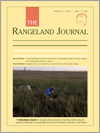
The Rangeland Journal
Volume 40 Number 2 2018
Understanding Ecosystem Functions in Grasslands Under Climate Change, Inner Mongolian Plateau, China
RJ16073Influence of climatic factors on variation in the Normalised Difference Vegetation Index in Mongolian Plateau grasslands
NDVI in Inner Mongolia and Mongolia grasslands showed similar temporal trends from 1981 to 2013 being positive to 1994, then negative to 2007. Climate factors showed substantial spatial variability and moisture was confirmed as the most important limiting factor on NDVI. Climate change, projected to involve temperature increases with little or no change in precipitation and ongoing spatial and temporal variability, can be expected to drive decreases in grassland productivity.
RJ16074Responses of aboveground biomass and soil organic carbon to projected future climate change in Inner Mongolian grasslands
Models can help decision makers to understand the potential impact of climate change. After finding that the CENTURY model simulated biomass and soil organic carbon in ungrazed Inner Mongolian grasslands with acceptable agreement, we used it to simulate these parameters under two climate-change scenarios: one intermediate and one substantial. Our findings that biomass increased on average in both scenarios while soil organic carbon decreased on average suggest opportunities for balancing sustainable land use and economic development.
RJ16097Temporal and spatial heterogeneity of drought impact on vegetation growth on the Inner Mongolian Plateau
Drought frequency and intensity have increased substantially on the Inner Mongolian Plateau, but the extent and timing of drought impacts on different vegetation types have not been clear. Our results show that drought reduced vegetation growth to the greatest extent in typical steppe and desert steppe and in summer, highlighting increased drought as a crucial factor driving changes in vegetation productivity.
RJ16075Nitrogen deposition changes the distribution of key plant species in the meadow steppe in Hulunbeier, China
The impact of increased nutrients on the spatial patterning of plant species was studied in meadow steppe in order to improve understanding of the effects of global increases in nitrogen deposition. We found that nitrogen deposition at different concentrations had varied impacts on interspecific associations, and that nitrogen and phosphorus applied in tandem increased spatial aggregation of a rhizomatous grass.
RJ16081Ecological responses of Stipa steppe in Inner Mongolia to experimentally increased temperature and precipitation 1: Background and experimental design
Design of an experiment to evaluate the effects of climate change on the Stipa steppe of Inner Mongolia is described. Experimental treatments simulated changes in temperature and precipitation similar to those projected for the region by mid-century. The treatments thus provide a framework for evaluation of the ecological effects of climate change on the grassland ecosystem, reported in companion papers.
RJ16082Ecological responses of Stipa steppe in Inner Mongolia to experimentally increased temperature and precipitation. 2. Plant species diversity and sward characteristics
Aspects of plant species diversity and sward characteristics were investigated in typical steppe in east of Xilinhot city, Inner Mongolia. Warming significantly increased biomass, density and diversity; however, increased precipitation without warming did not have significant effects.
RJ16083Ecological responses of Stipa steppe in Inner Mongolia to experimentally increased temperature and precipitation. 3. Soil respiration
On the Stipa steppe of Inner Mongolia, soil respiration was reduced by warming and elevated by increased precipitation, with the combination of warming and increased precipitation producing an intermediate result. Results suggest that soil respiration will be more sensitive to soil moisture than to soil temperature under anticipated climate changes in the region.
RJ16080Ecological responses of Stipa steppe in Inner Mongolia to experimentally increased temperature and precipitation. 4. Carbon exchange
Aspects of carbon exchange were investigated in Stipa steppe east of Xilinhot city in Inner Mongolia. Increased precipitation significantly increased soil respiration, ecosystem respiration, net ecosystem exchange and net ecosystem productivity whereas warming tended to reduce them.
RJ17047Ecological responses of Stipa steppe in Inner Mongolia to experimentally increased temperature and precipitation 5: Synthesis and implications
Experimental results indicate that predicted future climate involving warmer temperatures and 10–20% increased precipitation, could benefit the Stipa steppe vegetation community by increasing community diversity, biomass, gross ecosystem productivity and carbon sequestration.
RJ16084A comprehensive appraisal of four kinds of forage under irrigation in Xilingol, Inner Mongolia, China
The effects of irrigation on three varieties of lucerne (alfalfa) and a forage grass were studied in a field experiment in Inner Mongolia. Irrigation significantly increased forage quality in the lucerne varieties and substantially increased expected profits. Irrigation was less profitable for the grass.
RJ16086Response of plant functional traits at species and community levels to grazing exclusion on Inner Mongolian steppe, China
Variations in ecosystem function in response to land-use changes may be reflected in differences in the functional traits of plants. Species-level traits revealed that annual species were associated with rapid acquisition of resources, whereas perennial grasses were associated with conservation of resources. Community-level traits imply that grazing exclusion is beneficial to the recovery of carbon and to nutrient storage. Results support plant functional traits as indicators of environmental or management change, and for explaining changes in ecosystem function.
RJ18041Response of ecosystem functions to climate change and implications for sustainable development on the Inner Mongolian Plateau
Synthesis of contributions from this and two previous Special Issues on China’s rangelands indicates that future changes in climate will enhance ecosystem functions and increase flows of ecosystem services from Inner Mongolian rangelands, even though recent climate changes were a factor in degradation. Sustainable development will depend on people’s capacity to harness these benefits.



